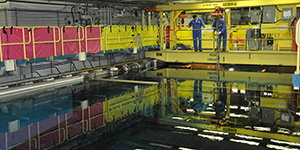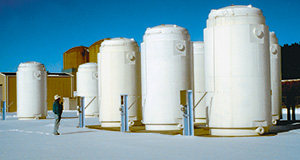Types of radioactive waste
Radioactive waste is generally divided into three categories depending on its level of radioactivity: low, intermediate and high-level waste.
- Low-level waste includes slightly contaminated clothing and items that comes from places such as nuclear medicine wards in hospitals, research laboratories and nuclear plants. Low-level waste contains only small amounts of radioactivity that decays away in hours or days. After the radioactivity has decayed, low-level waste can be treated like ordinary garbage.
- Intermediate-level wastes mostly come from the nuclear industry. They include used reactor components and contaminated materials from reactor decommissioning. Typically these wastes are embedded in concrete for disposal and buried.
- High-level waste generally describes spent (or used) fuel from nuclear reactors. It is highly radioactive, will remain so for many years, and requires special handling.
According to the IAEA, low and intermediate level wastes comprise about 97% of the volume, but only 8% of the radioactivity of all radioactive waste.
How much spent fuel is generated?

The overall volume of spent fuel produced by the nuclear power plants is very small, particularly when compared with other electricity generation means.
- Each year, nuclear power generation facilities worldwide produce about 12,000 tonnes of spent fuel.
- Canada’s 40 years of nuclear power generation has produced about 2 million spent CANDU fuel bundles. They would fit into an area the size of six hockey rinks from the ice surface to the top of the boards.
- In the U.S., after a half-century of operation, the nuclear energy industry’s 104 reactors have produced approximately 62,500 tonnes of used fuel. If stacked end to end, they would cover an area the size of a US football field to a depth of about 7 yards. Annually, about 2,000 tonnes of spent fuel is moved into reactor-site storage facilities.
- Today, there are about 270,000 tonnes of used fuel in storage worldwide, most of it at reactor sites. Although the volume of spent fuel produced is very small, the most important issue for the nuclear industry is safely managing it in ways that present no hazard to workers, the public or the natural environment. Nuclear power generation is the only large-scale energy producing industry that takes full responsibility for doing so and integrates waste management costs into the product.
Spent fuel management

The productive reactor life of a fuel assembly is between 3 to 6 years. Every 18 to 24 months, the reactor is shut down and about one-third of the fuel, consisting of the oldest assemblies are removed and replaced.
The spent fuel, which is very hot and radioactive when taken from the reactor, is initially stored in large water-filled pools. These large storage pools are constructed of thick, reinforced concrete lined with heavy stainless steel. The water and concrete provides effective radiation shielding for workers. A series of pumps circulate the water to remove heat, which continues to be generated by the radioactive decay of the spent fuel.
After a year submerged in water, the radioactivity level emitted by the fuel decreases to about 100th of what it was upon removal from the reactor, but it still remains quite hot. After 3 to 5 years, the heat and associated radioactivity have diminished to levels where the fuel can be more safely transferred to dry interim storage at, or near, the nuclear power plant. If the nuclear plant has no pressing need for additional storage pond space, the spent fuel can remain safely stored in these ponds for many more years.
About 90% of the world’s spent fuel is in storage ponds, some of it remaining there for decades, with the balance in dry interim storage.
Interim storage

Most interim storage facilities use specially engineered dry storage containers/casks (DSC) to securely provide robust shielding against radiation. In Canada, DSCs are constructed of reinforced, high-density concrete, about 20 inches thick and lined on all surfaces with half-inch thick steel plate. Each accommodates 384 spent CANDU fuel bundles and, when fully loaded, weighs about 73 tonnes.
DSCs are filled with helium gas, as a leak detector and inert atmosphere for the stored fuel, and is then welded shut to completely seal the unit. Each unit undergoes a series of rigorous tests, after which an inspector from the IAEA applies safeguard seals. The unit is secured within an interim, above-ground storage location. Here, the spent fuel safely continues the radioactive decay process over the course of many years.
While the specific designs of dry storage containers in other countries vary somewhat, universally their purposes are to:
- Provide adequate shielding
- Ensure units are impermeable and corrosion-resistant
- Can be closely monitored and kept secure until long-term disposal is available or the fuel can be reprocessed






